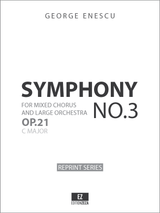
REPRINT SERIES
George Enescu’s Symphony No. 3 in C major, Op. 21, was composed between 1916 and 1918 and revised by the composer over subsequent decades; it was first performed under Enescu’s direction in Bucharest (often given the date 25 May 1919). The work is scored for very large forces—including expanded wind and brass sections, extensive percussion, piano, celesta, organ, two harps, very large strings and a wordless mixed chorus.
The symphony is in three movements (Moderato, un poco maestoso; Vivace ma non troppo; Lento ma non troppo) that make extensive use of cyclic thematic procedures: material introduced in the opening movement is transformed through a dark, scherzo-like second movement and a luminous, wordless-chorus-anchored finale that many commentators have likened to a Purgatory→Inferno→Paradise trilogy. Texturally it ranges from dense, martial sonorities to spare, almost transparent scoring in the closing pages, where a small bell and the chorus help create the work’s paradisal conclusion.
Typical recorded and performance durations fall roughly between 45 and 55 minutes (many sources and recordings average around 50 minutes), reflecting both the work’s large scale and variability in tempi; performances demand vast orchestral and choral resources, precise ensemble control across extreme dynamic ranges, and an understanding of Enescu’s cyclic, heterophonic treatment of motive and texture.
- Instrumentation:
- 4(3–4=picc.)–4(3–4=EH)–3(cl. + E♭ & bcl)–4(4=cbn); 6hn; 1–1–2tp–2cor–vlb–3tb–3tba; 2timp + perc(6); celesta–pno–organ; chorus; 2hp; str
- Duration:
- 45 to 55 minutes
- Set of Parts:
- Includes Strings count 5.5.4.4.3
- Extra Strings / Chorus Score:
- Only available with the purchase of the Set of Parts, and highly recommended given the high number of musicians required.
- Product Type:
- REPRINT SERIES






